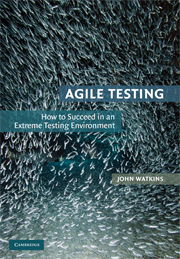Book contents
- Frontmatter
- Contents
- Foreword by Bob Bartlett
- Acknowledgments
- 1 Introduction
- PART 1 REVIEW OF OLD-SCHOOL AND AGILE APPROACHES
- PART 2 EVERYONE IS DIFFERENT: AGILE CASE STUDIES
- PART 3 AGILE MY WAY: A PROPOSAL FOR YOUR OWN AGILE TEST PROCESS
- APPENDIX A The Principles of Rapid Application Development
- APPENDIX B The Rules and Practices of Extreme Programming
- Appendix C The Principles of the Dynamic Systems Development Method
- Appendix D The Practices of Scrum
- APPENDIX E Agile Test Script Template
- Appendix F Agile Test Result Record Form Template
- Appendix G Agile Test Summary Report Template
- Appendix H My Agile Process Checklist
- References
- Index
Appendix D - The Practices of Scrum
Published online by Cambridge University Press: 26 October 2009
- Frontmatter
- Contents
- Foreword by Bob Bartlett
- Acknowledgments
- 1 Introduction
- PART 1 REVIEW OF OLD-SCHOOL AND AGILE APPROACHES
- PART 2 EVERYONE IS DIFFERENT: AGILE CASE STUDIES
- PART 3 AGILE MY WAY: A PROPOSAL FOR YOUR OWN AGILE TEST PROCESS
- APPENDIX A The Principles of Rapid Application Development
- APPENDIX B The Rules and Practices of Extreme Programming
- Appendix C The Principles of the Dynamic Systems Development Method
- Appendix D The Practices of Scrum
- APPENDIX E Agile Test Script Template
- Appendix F Agile Test Result Record Form Template
- Appendix G Agile Test Summary Report Template
- Appendix H My Agile Process Checklist
- References
- Index
Summary
A pig and a chicken are walking down a road. The chicken looks at the pig and says, “Hey, why don't we open a restaurant?” The pig looks back at the chicken and says, “Good idea, what do you want to call it?” The chicken thinks about it and says, “Why don't we call it ‘Ham and Eggs’?” “I don't think so,” says the pig, “I'd be committed but you'd only be involved!”
Introduction
This appendix reviews the essential rules and practices of Scrum, focusing in more detail on the testing aspects of the method.
The Scrum rules and practices are discussed under the following sections:
Scrum General Practices,
Scrum Roles and Responsibilities,
The Sprint,
Scrum Meetings, and
Scrum Artifacts.
Scrum General Practices
Customers must become a part of the development team; it is essential that the customer is genuinely interested in the success of the project.
There should be frequent intermediate deliveries with working functionality; this enables the customer to get exposure to working software earlier and enables the project to change its requirements according to changing needs.
The development team should be alert to project risks and develop appropriate mitigation strategies; valid risk mitigation, monitoring, and management should be actively performed throughout the project.
Problems, issues, and risks must not be swept under the carpet; no one should be penalized for identifying or highlighting any unforeseen problem.
There should be transparency in planning and module development; everyone must be aware of who is accountable for what and by when.
Frequent stakeholder meetings should be held to monitor progress, with dashboard/stakeholders' updates; procedures must be put in place to ensure visibility of potential slippage or deviation in a timely manner to allow it to be corrected.
[…]
- Type
- Chapter
- Information
- Agile TestingHow to Succeed in an Extreme Testing Environment, pp. 279 - 283Publisher: Cambridge University PressPrint publication year: 2009



